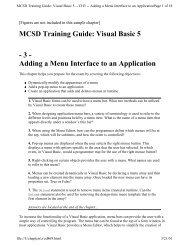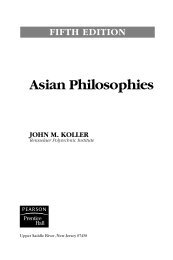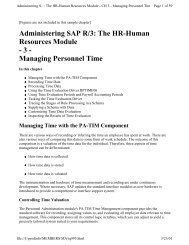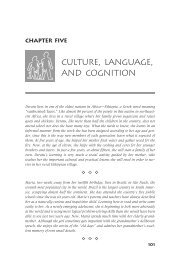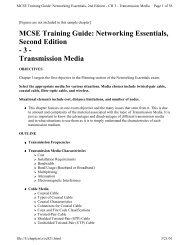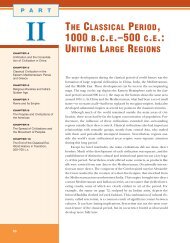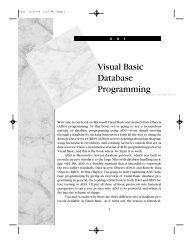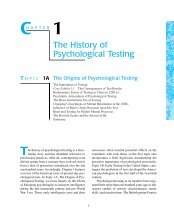SOCIAL PROBLEMS: A Down-to-Earth Approach, 8/e
SOCIAL PROBLEMS: A Down-to-Earth Approach, 8/e
SOCIAL PROBLEMS: A Down-to-Earth Approach, 8/e
You also want an ePaper? Increase the reach of your titles
YUMPU automatically turns print PDFs into web optimized ePapers that Google loves.
California and five other states <strong>to</strong> codify Roe, that is, <strong>to</strong><br />
guarantee abortion rights in their states if Roe is overturned<br />
(Solomon 2006).<br />
MAKING MUTUAL ACCUSATIONS. Part of the alternative<br />
strategy of each side is <strong>to</strong> point the finger at the other.<br />
As it promotes its own point of view, each side paints the<br />
other as grotesque, uncaring, and evil. Proabortionists<br />
accuse antiabortionists of being concerned about fetuses<br />
but not about pregnant women. They also point <strong>to</strong> the<br />
killing of physicians as evidence of hypocrisy—people<br />
who say they stand for life kill others. For their part,<br />
antiabortionists accuse proabortionists of suppressing<br />
information about the health risks of abortion—and of<br />
murdering helpless, innocent, unborn children.<br />
The eight men and one woman who serve for life on the U.S.<br />
THE CONTROVERSY CONTINUES: THE SUPREME COURT Supreme Court determine the constitutionality of the laws passed<br />
AFTER ROE. As each side knows so well, the U.S. by the states and the U.S. Congress. Because their interpretations<br />
Supreme Court remains the final arbiter of abortion. of the U.S. Constitution are biased by their political and personal<br />
Short of a constitutional amendment, if either side on views, their rulings on matters concerning abortion are uncertain.<br />
this issue succeeds in getting a state, or even Congress,<br />
<strong>to</strong> pass some law, the Supreme Court decides whether that law is constitutional.<br />
Consequently, a primary alternative strategy of both proabortionists and antiabortionists<br />
is <strong>to</strong> try <strong>to</strong> influence the president’s choice of Supreme Court nominees and how the Senate<br />
votes on them. For the past couple of decades, U.S. presidents have taken strong positions<br />
on abortion and have proposed nominees for the Supreme Court that reflect their<br />
position. We can expect this stacking of the Court <strong>to</strong> continue.<br />
Three Supreme Court decisions since the 1973 Roe v. Wade decision are especially significant.<br />
The first is Webster v. Reproductive Services. In 1989, by a vote of 5–4, the Supreme<br />
Court ruled that<br />
1. States have no obligation <strong>to</strong> finance abortion: They can prohibit the use of public funds<br />
for abortions and abortion counseling, and they can ban abortions at public hospitals.<br />
2. States have a compelling interest <strong>to</strong> protect fetal life: Before doc<strong>to</strong>rs can abort a fetus<br />
that is 20 weeks or over, they must perform tests <strong>to</strong> determine its viability (capacity<br />
<strong>to</strong> live outside the uterus).<br />
The second significant decision is Casey v. Planned Parenthood. In 1992, by a vote of<br />
6 <strong>to</strong> 3, the Supreme Court upheld a Pennsylvania law requiring that a woman under age<br />
18 obtain the consent of at least one parent, that a 24-hour waiting period between confirming<br />
a pregnancy and having an abortion be enforced, and that the woman be given<br />
materials describing the fetus, as well as a list of agencies offering adoption services and<br />
alternatives <strong>to</strong> abortion. By a 5–4 vote, however, the Court also ruled that a wife has no<br />
obligation <strong>to</strong> inform her husband of her intention <strong>to</strong> have an abortion. Casey allows states<br />
<strong>to</strong> pass laws that restrict abortion—unless such laws impose an “undue burden” on a<br />
woman’s ability <strong>to</strong> have an abortion.<br />
A third significant legal decision occurred in 1993, this time in favor of the proabortion<br />
forces. In that year, they won a major vic<strong>to</strong>ry when Congress passed the Freedom of<br />
Access <strong>to</strong> Clinic Entrances Act. This law requires picketers and other demonstra<strong>to</strong>rs <strong>to</strong><br />
remain 300 feet away from the entrances <strong>to</strong> abortion clinics. If demonstra<strong>to</strong>rs don’t, they<br />
face up <strong>to</strong> three years in prison. The Supreme Court has ruled that this Act does not violate<br />
freedom of speech. This significant vic<strong>to</strong>ry for the proabortion side practically eliminated<br />
the picketing of abortion clinics.<br />
NO MIDDLE GROUND. Neither the proabortionists nor the antiabortionists can be satisfied,<br />
as there is no middle ground. Both sides consider their alternative strategies as only nibbling<br />
at the edges of the problem. Each seeks <strong>to</strong>tal vic<strong>to</strong>ry. The antiabortion groups advocate<br />
a constitutional amendment that would define human life as beginning at conception<br />
THE NATURAL HISTORY OF <strong>SOCIAL</strong> <strong>PROBLEMS</strong>: FOUR STAGES 13





